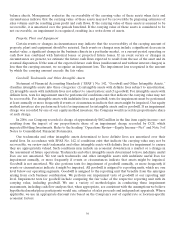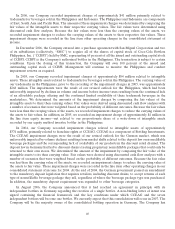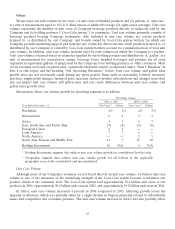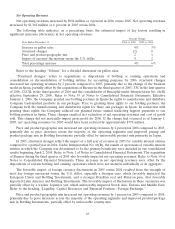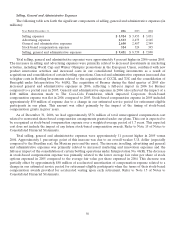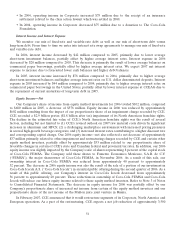Coca Cola 2006 Annual Report Download - page 47
Download and view the complete annual report
Please find page 47 of the 2006 Coca Cola annual report below. You can navigate through the pages in the report by either clicking on the pages listed below, or by using the keyword search tool below to find specific information within the annual report.Beverage, LLC, maker of Fuze enhanced juices, teas, waters and energy drinks. The Company expects
performance in North America to be weak during 2007.
In North Asia, Eurasia and Middle East, unit case volume grew 11 percent in 2006 compared to 2005, led by
double-digit growth in China, Russia and Turkey, partially offset by a 3 percent decline in Japan. The increase in
unit case volume in China was led by significant growth in both sparkling and still beverages. The unit case
volume growth in Russia and Turkey was the result of improving macroeconomic trends, strong bottler execution
and successful marketing programs. Unit case volume in Russia also benefited from the full-year impact of the
joint acquisition of Multon, compared to a partial year in 2005. The Company and Coca-Cola HBC jointly
acquired Multon, a Russian juice company, in April 2005. The decrease in unit case volume in Japan was
primarily due to weakness across core brands including Trademark Coca-Cola, Georgia Coffee and our green
tea brands. However, results in Japan gradually improved during 2006 and position Japan for growth in 2007.
Unit case volume for Bottling Investments increased 16 percent in 2006 versus 2005, primarily due to the
acquisition of Kerry Beverages Limited, which was subsequently renamed Coca-Cola China Industries Limited
(‘‘CCCIL’’), and the acquisitions of TJC Holdings (Pty) Ltd., a South African bottling company (‘‘TJC’’), and
Apollinaris. The Company intends to sell a portion of its investment in TJC to Black Economic Empowerment
entities at a future date. Unit case volume for Bottling Investments also increased due to the consolidation of
Brucephil, Inc. (‘‘Brucephil’’), the parent company of The Philadelphia Coca-Cola Bottling Company. In the
third quarter of 2006, our Company signed agreements with J. Bruce Llewellyn and Brucephil for the potential
purchase of the remaining shares of Brucephil not currently owned by the Company. The agreements provide
for the Company’s purchase of the shares upon the election of Mr. Llewellyn or the election of the Company.
Based on the terms of these agreements, the Company concluded that it must consolidate Brucephil under
Interpretation No. 46(R). Brucephil’s financial statements were consolidated effective September 29, 2006. The
acquisition of the German bottling company Bremer Erfrischungsgetraenke GmbH (‘‘Bremer’’) during the third
quarter of 2005 also contributed to unit case volume increases in 2006, reflecting the impact of full-year unit case
volume in 2006 for Bremer compared to a partial year in 2005. The unit case volume increase was partially offset
by a decline in India.
In Africa, unit case volume increased 6 percent in 2005 compared to 2004. This increase was driven by
growth in core sparkling beverages as well as still beverages across all divisions in this operating segment.
In East, South Asia and Pacific Rim, unit case volume decreased 4 percent in 2005 compared to 2004,
primarily due to declines in India and the Philippines. The decline in India was related to the impact of price
increases to cover rising raw material and distribution costs and the lingering effects of the 2003 pesticide
allegations. The decline in the Philippines was primarily related to affordability and availability issues.
Unit case volume in the European Union was even in 2005 versus 2004, primarily due to strong growth in
Spain and Central Europe partially offset by declines primarily in Germany and Northwest Europe. Unit case
volume in Germany declined 2 percent in 2005 due to the continued impact of the mandatory deposit legislation
on the availability of nonrefillable packages and the corresponding limited availability of our products in the
discount retail channel, along with overall industry weakness. In the second half of 2005, the Company achieved
availability of a limited range of its products in most discounters. Results in Germany stabilized in the second
half of 2005. Unit case volume in Northwest Europe declined 3 percent in 2005, primarily due to the soft
economic environment and declines in sparkling beverages, which was associated with a decrease in competitors’
prices at retailers, and the discount channel becoming a larger part of the retail market, together with a shift in
consumer preferences away from regular sparkling beverages driven by health and wellness trends and the
associated public opinion, media and government attention.
Unit case volume for Latin America increased 6 percent in 2005 versus 2004, reflecting strong growth in
Brazil, Argentina and Mexico, primarily due to growth in sparkling beverages. The increase in Brazil and Mexico
was primarily due to strong marketing, execution and package innovation.
45






